HSBC: IT's Role, Ethical, Social Issues, and Networking Analysis
VerifiedAdded on 2022/12/28
|12
|3238
|84
Report
AI Summary
This report examines the critical role of Information Technology (IT) in business success, using HSBC Holdings PLC as a case study. It explores how IT contributes to a company's achievements, focusing on improved communication, operational efficiency, and enhanced customer experiences. The report delves into ethical and social issues associated with IT, such as data privacy and security, and analyzes various networking technologies, including LAN, MAN, and WAN. Furthermore, it discusses the importance of social media in business, highlighting its role in gaining traffic and conducting market research. The report also outlines the different stages of the software development life cycle. This comprehensive analysis provides insights into how IT strategies can be leveraged for business growth and addresses the challenges businesses face in the digital age.
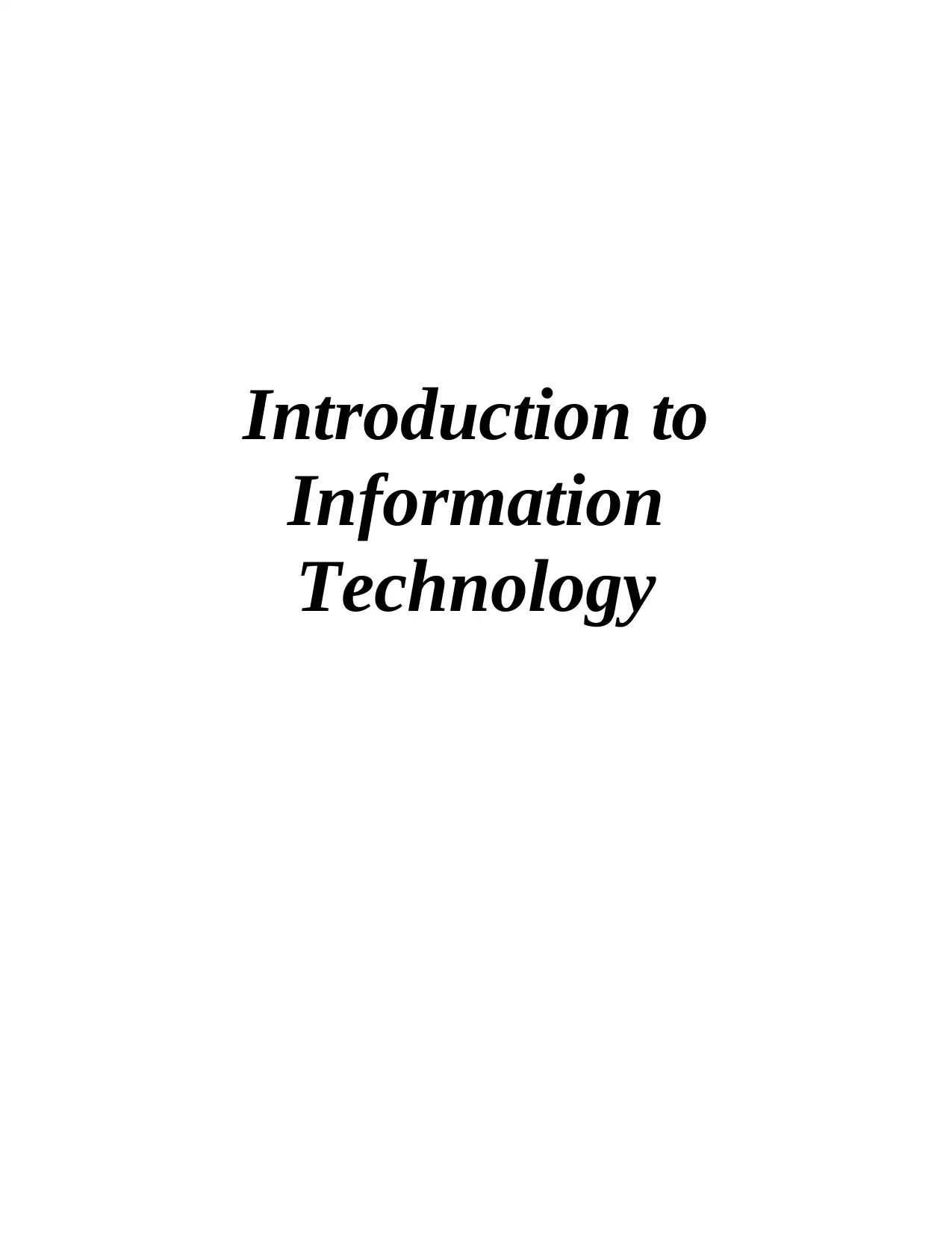
Introduction to
Information
Technology
Information
Technology
Paraphrase This Document
Need a fresh take? Get an instant paraphrase of this document with our AI Paraphraser
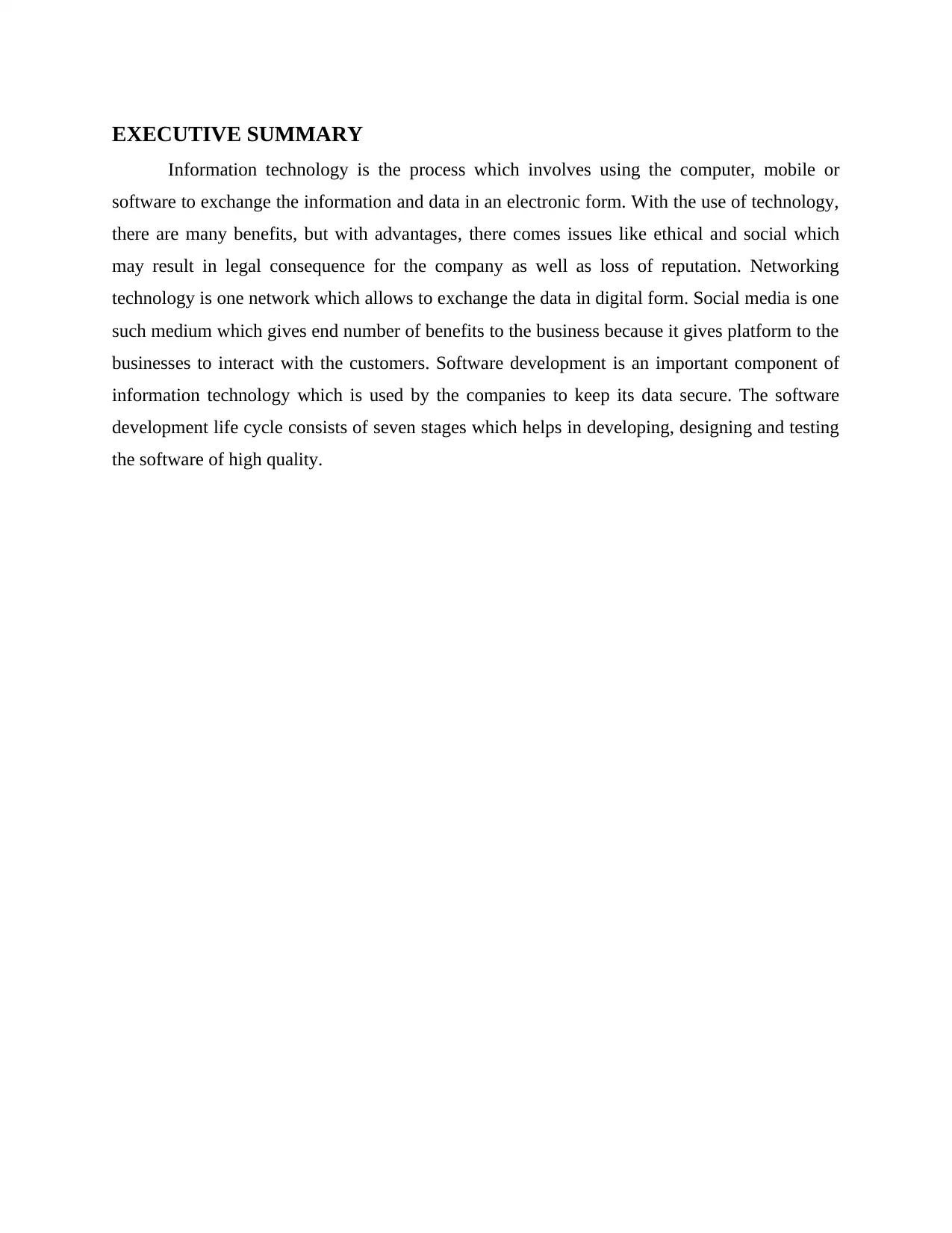
EXECUTIVE SUMMARY
Information technology is the process which involves using the computer, mobile or
software to exchange the information and data in an electronic form. With the use of technology,
there are many benefits, but with advantages, there comes issues like ethical and social which
may result in legal consequence for the company as well as loss of reputation. Networking
technology is one network which allows to exchange the data in digital form. Social media is one
such medium which gives end number of benefits to the business because it gives platform to the
businesses to interact with the customers. Software development is an important component of
information technology which is used by the companies to keep its data secure. The software
development life cycle consists of seven stages which helps in developing, designing and testing
the software of high quality.
Information technology is the process which involves using the computer, mobile or
software to exchange the information and data in an electronic form. With the use of technology,
there are many benefits, but with advantages, there comes issues like ethical and social which
may result in legal consequence for the company as well as loss of reputation. Networking
technology is one network which allows to exchange the data in digital form. Social media is one
such medium which gives end number of benefits to the business because it gives platform to the
businesses to interact with the customers. Software development is an important component of
information technology which is used by the companies to keep its data secure. The software
development life cycle consists of seven stages which helps in developing, designing and testing
the software of high quality.
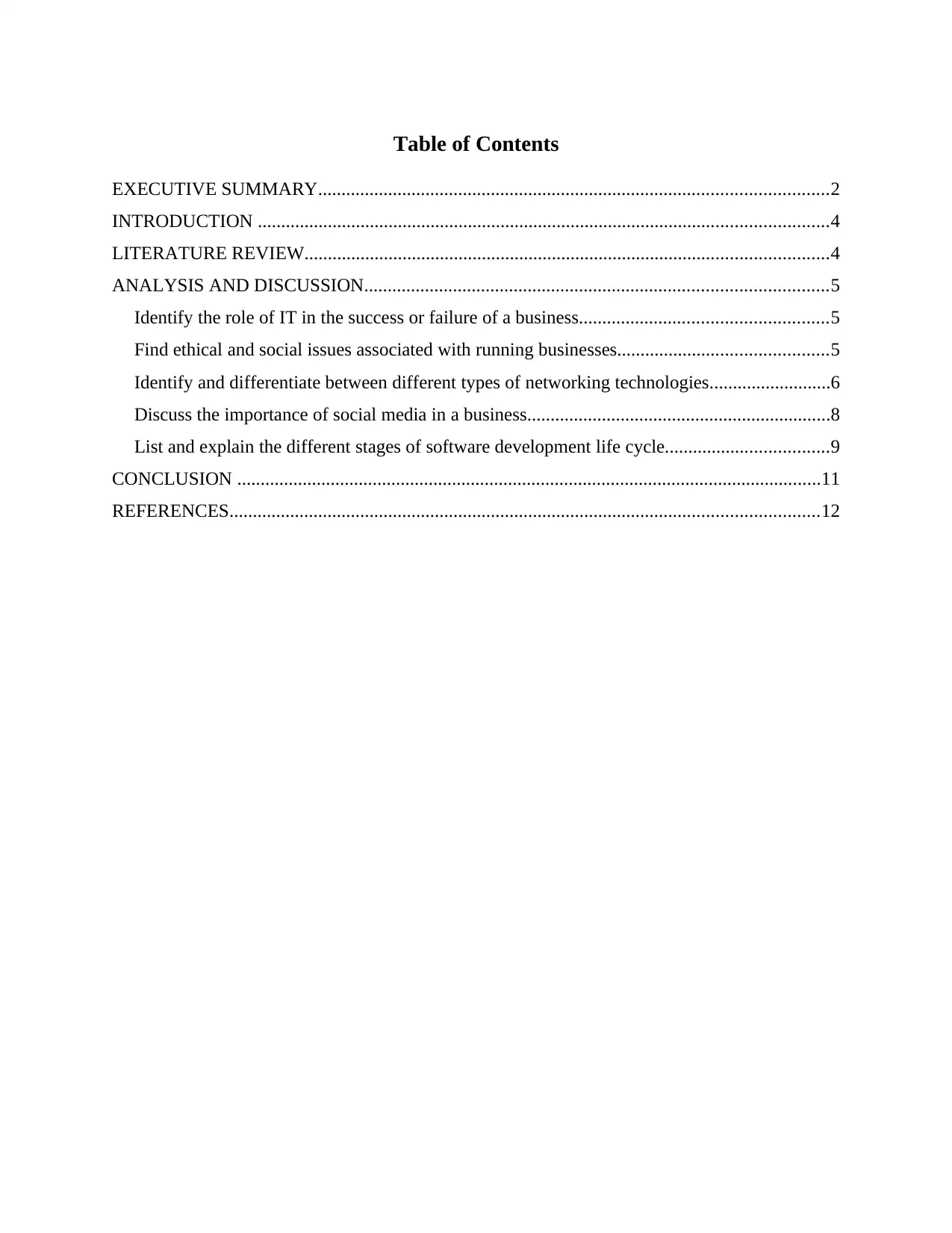
Table of Contents
EXECUTIVE SUMMARY.............................................................................................................2
INTRODUCTION ..........................................................................................................................4
LITERATURE REVIEW................................................................................................................4
ANALYSIS AND DISCUSSION...................................................................................................5
Identify the role of IT in the success or failure of a business.....................................................5
Find ethical and social issues associated with running businesses.............................................5
Identify and differentiate between different types of networking technologies..........................6
Discuss the importance of social media in a business.................................................................8
List and explain the different stages of software development life cycle...................................9
CONCLUSION .............................................................................................................................11
REFERENCES..............................................................................................................................12
EXECUTIVE SUMMARY.............................................................................................................2
INTRODUCTION ..........................................................................................................................4
LITERATURE REVIEW................................................................................................................4
ANALYSIS AND DISCUSSION...................................................................................................5
Identify the role of IT in the success or failure of a business.....................................................5
Find ethical and social issues associated with running businesses.............................................5
Identify and differentiate between different types of networking technologies..........................6
Discuss the importance of social media in a business.................................................................8
List and explain the different stages of software development life cycle...................................9
CONCLUSION .............................................................................................................................11
REFERENCES..............................................................................................................................12
⊘ This is a preview!⊘
Do you want full access?
Subscribe today to unlock all pages.

Trusted by 1+ million students worldwide
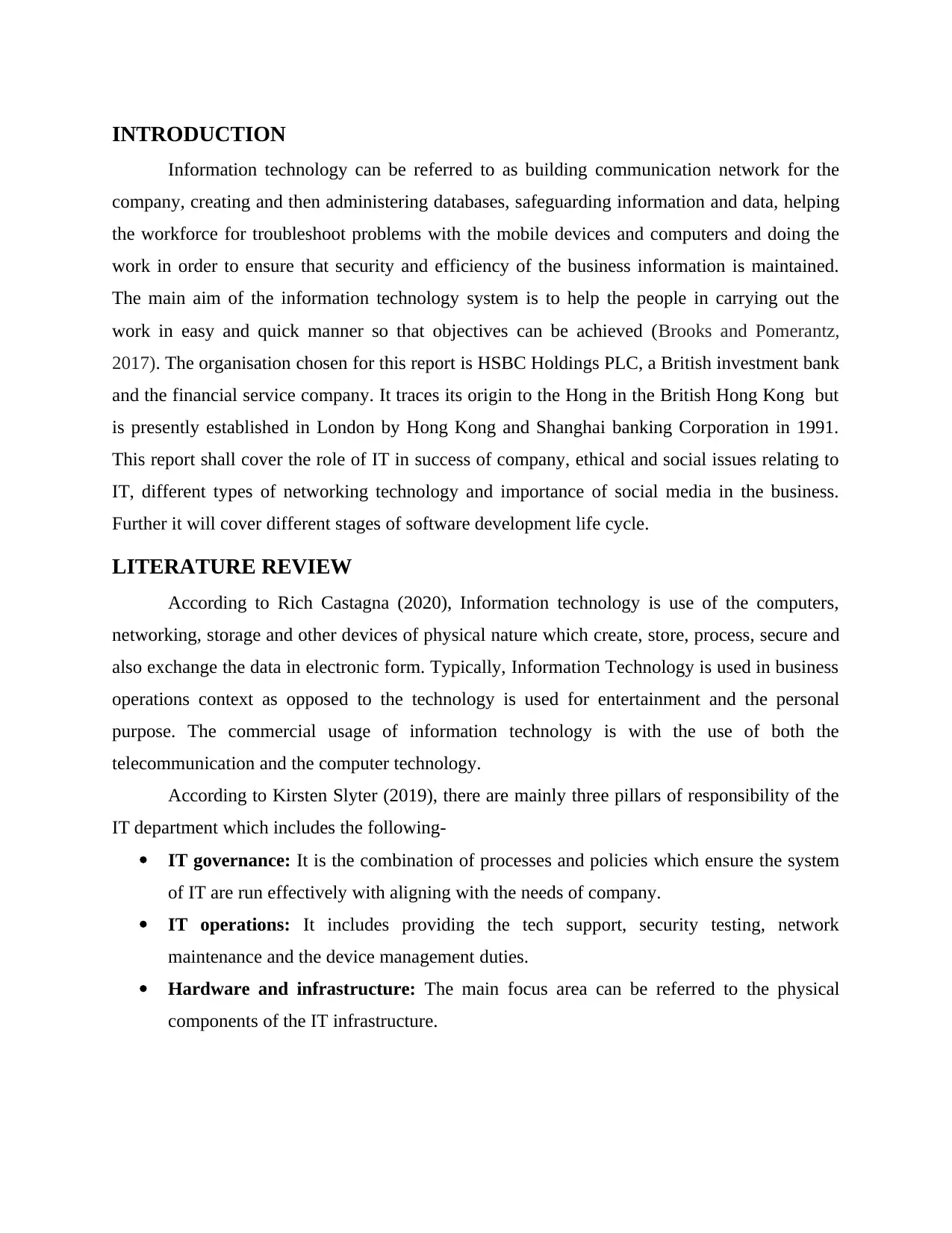
INTRODUCTION
Information technology can be referred to as building communication network for the
company, creating and then administering databases, safeguarding information and data, helping
the workforce for troubleshoot problems with the mobile devices and computers and doing the
work in order to ensure that security and efficiency of the business information is maintained.
The main aim of the information technology system is to help the people in carrying out the
work in easy and quick manner so that objectives can be achieved (Brooks and Pomerantz,
2017). The organisation chosen for this report is HSBC Holdings PLC, a British investment bank
and the financial service company. It traces its origin to the Hong in the British Hong Kong but
is presently established in London by Hong Kong and Shanghai banking Corporation in 1991.
This report shall cover the role of IT in success of company, ethical and social issues relating to
IT, different types of networking technology and importance of social media in the business.
Further it will cover different stages of software development life cycle.
LITERATURE REVIEW
According to Rich Castagna (2020), Information technology is use of the computers,
networking, storage and other devices of physical nature which create, store, process, secure and
also exchange the data in electronic form. Typically, Information Technology is used in business
operations context as opposed to the technology is used for entertainment and the personal
purpose. The commercial usage of information technology is with the use of both the
telecommunication and the computer technology.
According to Kirsten Slyter (2019), there are mainly three pillars of responsibility of the
IT department which includes the following-
IT governance: It is the combination of processes and policies which ensure the system
of IT are run effectively with aligning with the needs of company.
IT operations: It includes providing the tech support, security testing, network
maintenance and the device management duties.
Hardware and infrastructure: The main focus area can be referred to the physical
components of the IT infrastructure.
Information technology can be referred to as building communication network for the
company, creating and then administering databases, safeguarding information and data, helping
the workforce for troubleshoot problems with the mobile devices and computers and doing the
work in order to ensure that security and efficiency of the business information is maintained.
The main aim of the information technology system is to help the people in carrying out the
work in easy and quick manner so that objectives can be achieved (Brooks and Pomerantz,
2017). The organisation chosen for this report is HSBC Holdings PLC, a British investment bank
and the financial service company. It traces its origin to the Hong in the British Hong Kong but
is presently established in London by Hong Kong and Shanghai banking Corporation in 1991.
This report shall cover the role of IT in success of company, ethical and social issues relating to
IT, different types of networking technology and importance of social media in the business.
Further it will cover different stages of software development life cycle.
LITERATURE REVIEW
According to Rich Castagna (2020), Information technology is use of the computers,
networking, storage and other devices of physical nature which create, store, process, secure and
also exchange the data in electronic form. Typically, Information Technology is used in business
operations context as opposed to the technology is used for entertainment and the personal
purpose. The commercial usage of information technology is with the use of both the
telecommunication and the computer technology.
According to Kirsten Slyter (2019), there are mainly three pillars of responsibility of the
IT department which includes the following-
IT governance: It is the combination of processes and policies which ensure the system
of IT are run effectively with aligning with the needs of company.
IT operations: It includes providing the tech support, security testing, network
maintenance and the device management duties.
Hardware and infrastructure: The main focus area can be referred to the physical
components of the IT infrastructure.
Paraphrase This Document
Need a fresh take? Get an instant paraphrase of this document with our AI Paraphraser
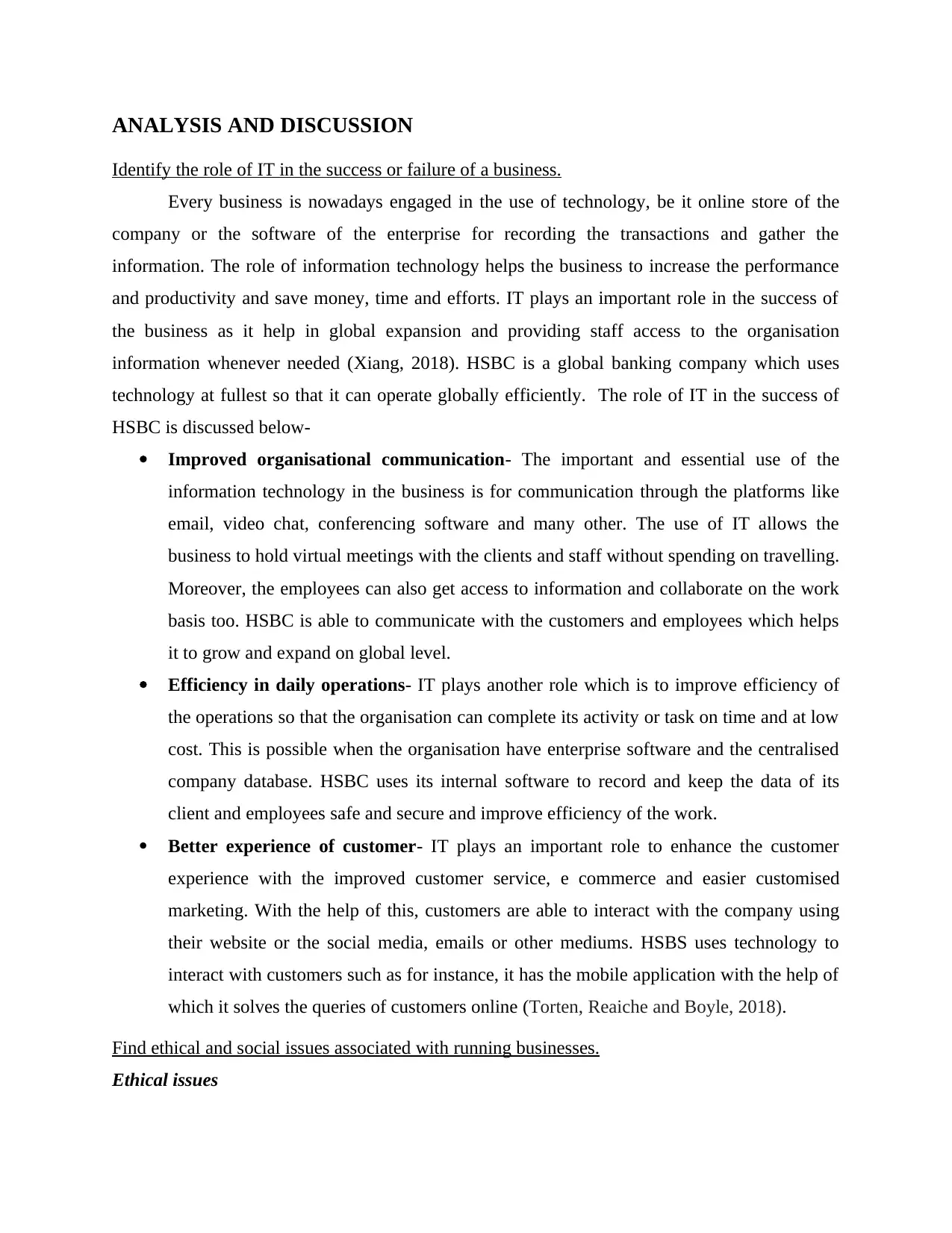
ANALYSIS AND DISCUSSION
Identify the role of IT in the success or failure of a business.
Every business is nowadays engaged in the use of technology, be it online store of the
company or the software of the enterprise for recording the transactions and gather the
information. The role of information technology helps the business to increase the performance
and productivity and save money, time and efforts. IT plays an important role in the success of
the business as it help in global expansion and providing staff access to the organisation
information whenever needed (Xiang, 2018). HSBC is a global banking company which uses
technology at fullest so that it can operate globally efficiently. The role of IT in the success of
HSBC is discussed below-
Improved organisational communication- The important and essential use of the
information technology in the business is for communication through the platforms like
email, video chat, conferencing software and many other. The use of IT allows the
business to hold virtual meetings with the clients and staff without spending on travelling.
Moreover, the employees can also get access to information and collaborate on the work
basis too. HSBC is able to communicate with the customers and employees which helps
it to grow and expand on global level.
Efficiency in daily operations- IT plays another role which is to improve efficiency of
the operations so that the organisation can complete its activity or task on time and at low
cost. This is possible when the organisation have enterprise software and the centralised
company database. HSBC uses its internal software to record and keep the data of its
client and employees safe and secure and improve efficiency of the work.
Better experience of customer- IT plays an important role to enhance the customer
experience with the improved customer service, e commerce and easier customised
marketing. With the help of this, customers are able to interact with the company using
their website or the social media, emails or other mediums. HSBS uses technology to
interact with customers such as for instance, it has the mobile application with the help of
which it solves the queries of customers online (Torten, Reaiche and Boyle, 2018).
Find ethical and social issues associated with running businesses.
Ethical issues
Identify the role of IT in the success or failure of a business.
Every business is nowadays engaged in the use of technology, be it online store of the
company or the software of the enterprise for recording the transactions and gather the
information. The role of information technology helps the business to increase the performance
and productivity and save money, time and efforts. IT plays an important role in the success of
the business as it help in global expansion and providing staff access to the organisation
information whenever needed (Xiang, 2018). HSBC is a global banking company which uses
technology at fullest so that it can operate globally efficiently. The role of IT in the success of
HSBC is discussed below-
Improved organisational communication- The important and essential use of the
information technology in the business is for communication through the platforms like
email, video chat, conferencing software and many other. The use of IT allows the
business to hold virtual meetings with the clients and staff without spending on travelling.
Moreover, the employees can also get access to information and collaborate on the work
basis too. HSBC is able to communicate with the customers and employees which helps
it to grow and expand on global level.
Efficiency in daily operations- IT plays another role which is to improve efficiency of
the operations so that the organisation can complete its activity or task on time and at low
cost. This is possible when the organisation have enterprise software and the centralised
company database. HSBC uses its internal software to record and keep the data of its
client and employees safe and secure and improve efficiency of the work.
Better experience of customer- IT plays an important role to enhance the customer
experience with the improved customer service, e commerce and easier customised
marketing. With the help of this, customers are able to interact with the company using
their website or the social media, emails or other mediums. HSBS uses technology to
interact with customers such as for instance, it has the mobile application with the help of
which it solves the queries of customers online (Torten, Reaiche and Boyle, 2018).
Find ethical and social issues associated with running businesses.
Ethical issues
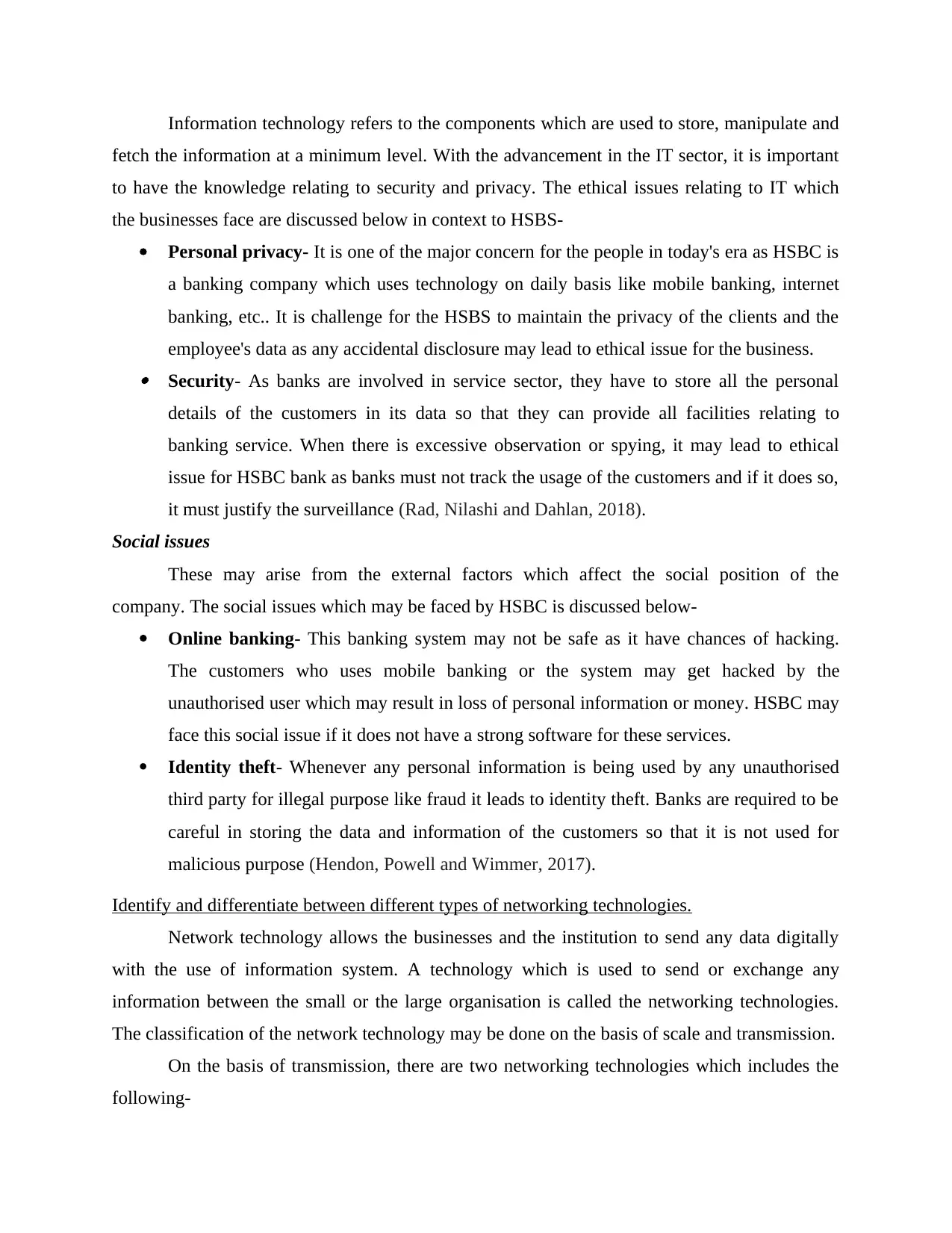
Information technology refers to the components which are used to store, manipulate and
fetch the information at a minimum level. With the advancement in the IT sector, it is important
to have the knowledge relating to security and privacy. The ethical issues relating to IT which
the businesses face are discussed below in context to HSBS-
Personal privacy- It is one of the major concern for the people in today's era as HSBC is
a banking company which uses technology on daily basis like mobile banking, internet
banking, etc.. It is challenge for the HSBS to maintain the privacy of the clients and the
employee's data as any accidental disclosure may lead to ethical issue for the business. Security- As banks are involved in service sector, they have to store all the personal
details of the customers in its data so that they can provide all facilities relating to
banking service. When there is excessive observation or spying, it may lead to ethical
issue for HSBC bank as banks must not track the usage of the customers and if it does so,
it must justify the surveillance (Rad, Nilashi and Dahlan, 2018).
Social issues
These may arise from the external factors which affect the social position of the
company. The social issues which may be faced by HSBC is discussed below-
Online banking- This banking system may not be safe as it have chances of hacking.
The customers who uses mobile banking or the system may get hacked by the
unauthorised user which may result in loss of personal information or money. HSBC may
face this social issue if it does not have a strong software for these services.
Identity theft- Whenever any personal information is being used by any unauthorised
third party for illegal purpose like fraud it leads to identity theft. Banks are required to be
careful in storing the data and information of the customers so that it is not used for
malicious purpose (Hendon, Powell and Wimmer, 2017).
Identify and differentiate between different types of networking technologies.
Network technology allows the businesses and the institution to send any data digitally
with the use of information system. A technology which is used to send or exchange any
information between the small or the large organisation is called the networking technologies.
The classification of the network technology may be done on the basis of scale and transmission.
On the basis of transmission, there are two networking technologies which includes the
following-
fetch the information at a minimum level. With the advancement in the IT sector, it is important
to have the knowledge relating to security and privacy. The ethical issues relating to IT which
the businesses face are discussed below in context to HSBS-
Personal privacy- It is one of the major concern for the people in today's era as HSBC is
a banking company which uses technology on daily basis like mobile banking, internet
banking, etc.. It is challenge for the HSBS to maintain the privacy of the clients and the
employee's data as any accidental disclosure may lead to ethical issue for the business. Security- As banks are involved in service sector, they have to store all the personal
details of the customers in its data so that they can provide all facilities relating to
banking service. When there is excessive observation or spying, it may lead to ethical
issue for HSBC bank as banks must not track the usage of the customers and if it does so,
it must justify the surveillance (Rad, Nilashi and Dahlan, 2018).
Social issues
These may arise from the external factors which affect the social position of the
company. The social issues which may be faced by HSBC is discussed below-
Online banking- This banking system may not be safe as it have chances of hacking.
The customers who uses mobile banking or the system may get hacked by the
unauthorised user which may result in loss of personal information or money. HSBC may
face this social issue if it does not have a strong software for these services.
Identity theft- Whenever any personal information is being used by any unauthorised
third party for illegal purpose like fraud it leads to identity theft. Banks are required to be
careful in storing the data and information of the customers so that it is not used for
malicious purpose (Hendon, Powell and Wimmer, 2017).
Identify and differentiate between different types of networking technologies.
Network technology allows the businesses and the institution to send any data digitally
with the use of information system. A technology which is used to send or exchange any
information between the small or the large organisation is called the networking technologies.
The classification of the network technology may be done on the basis of scale and transmission.
On the basis of transmission, there are two networking technologies which includes the
following-
⊘ This is a preview!⊘
Do you want full access?
Subscribe today to unlock all pages.

Trusted by 1+ million students worldwide
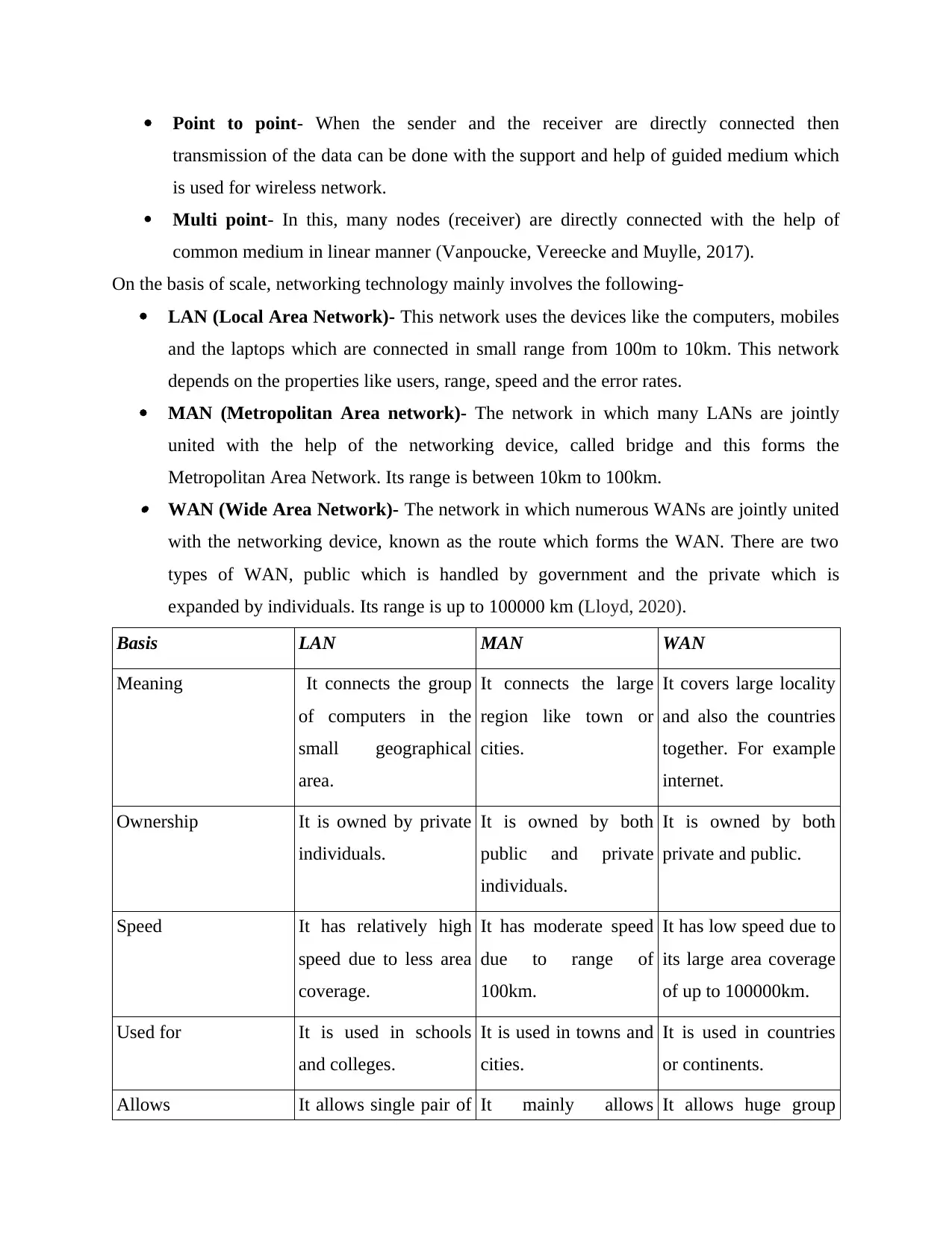
Point to point- When the sender and the receiver are directly connected then
transmission of the data can be done with the support and help of guided medium which
is used for wireless network.
Multi point- In this, many nodes (receiver) are directly connected with the help of
common medium in linear manner (Vanpoucke, Vereecke and Muylle, 2017).
On the basis of scale, networking technology mainly involves the following-
LAN (Local Area Network)- This network uses the devices like the computers, mobiles
and the laptops which are connected in small range from 100m to 10km. This network
depends on the properties like users, range, speed and the error rates.
MAN (Metropolitan Area network)- The network in which many LANs are jointly
united with the help of the networking device, called bridge and this forms the
Metropolitan Area Network. Its range is between 10km to 100km. WAN (Wide Area Network)- The network in which numerous WANs are jointly united
with the networking device, known as the route which forms the WAN. There are two
types of WAN, public which is handled by government and the private which is
expanded by individuals. Its range is up to 100000 km (Lloyd, 2020).
Basis LAN MAN WAN
Meaning It connects the group
of computers in the
small geographical
area.
It connects the large
region like town or
cities.
It covers large locality
and also the countries
together. For example
internet.
Ownership It is owned by private
individuals.
It is owned by both
public and private
individuals.
It is owned by both
private and public.
Speed It has relatively high
speed due to less area
coverage.
It has moderate speed
due to range of
100km.
It has low speed due to
its large area coverage
of up to 100000km.
Used for It is used in schools
and colleges.
It is used in towns and
cities.
It is used in countries
or continents.
Allows It allows single pair of It mainly allows It allows huge group
transmission of the data can be done with the support and help of guided medium which
is used for wireless network.
Multi point- In this, many nodes (receiver) are directly connected with the help of
common medium in linear manner (Vanpoucke, Vereecke and Muylle, 2017).
On the basis of scale, networking technology mainly involves the following-
LAN (Local Area Network)- This network uses the devices like the computers, mobiles
and the laptops which are connected in small range from 100m to 10km. This network
depends on the properties like users, range, speed and the error rates.
MAN (Metropolitan Area network)- The network in which many LANs are jointly
united with the help of the networking device, called bridge and this forms the
Metropolitan Area Network. Its range is between 10km to 100km. WAN (Wide Area Network)- The network in which numerous WANs are jointly united
with the networking device, known as the route which forms the WAN. There are two
types of WAN, public which is handled by government and the private which is
expanded by individuals. Its range is up to 100000 km (Lloyd, 2020).
Basis LAN MAN WAN
Meaning It connects the group
of computers in the
small geographical
area.
It connects the large
region like town or
cities.
It covers large locality
and also the countries
together. For example
internet.
Ownership It is owned by private
individuals.
It is owned by both
public and private
individuals.
It is owned by both
private and public.
Speed It has relatively high
speed due to less area
coverage.
It has moderate speed
due to range of
100km.
It has low speed due to
its large area coverage
of up to 100000km.
Used for It is used in schools
and colleges.
It is used in towns and
cities.
It is used in countries
or continents.
Allows It allows single pair of It mainly allows It allows huge group
Paraphrase This Document
Need a fresh take? Get an instant paraphrase of this document with our AI Paraphraser
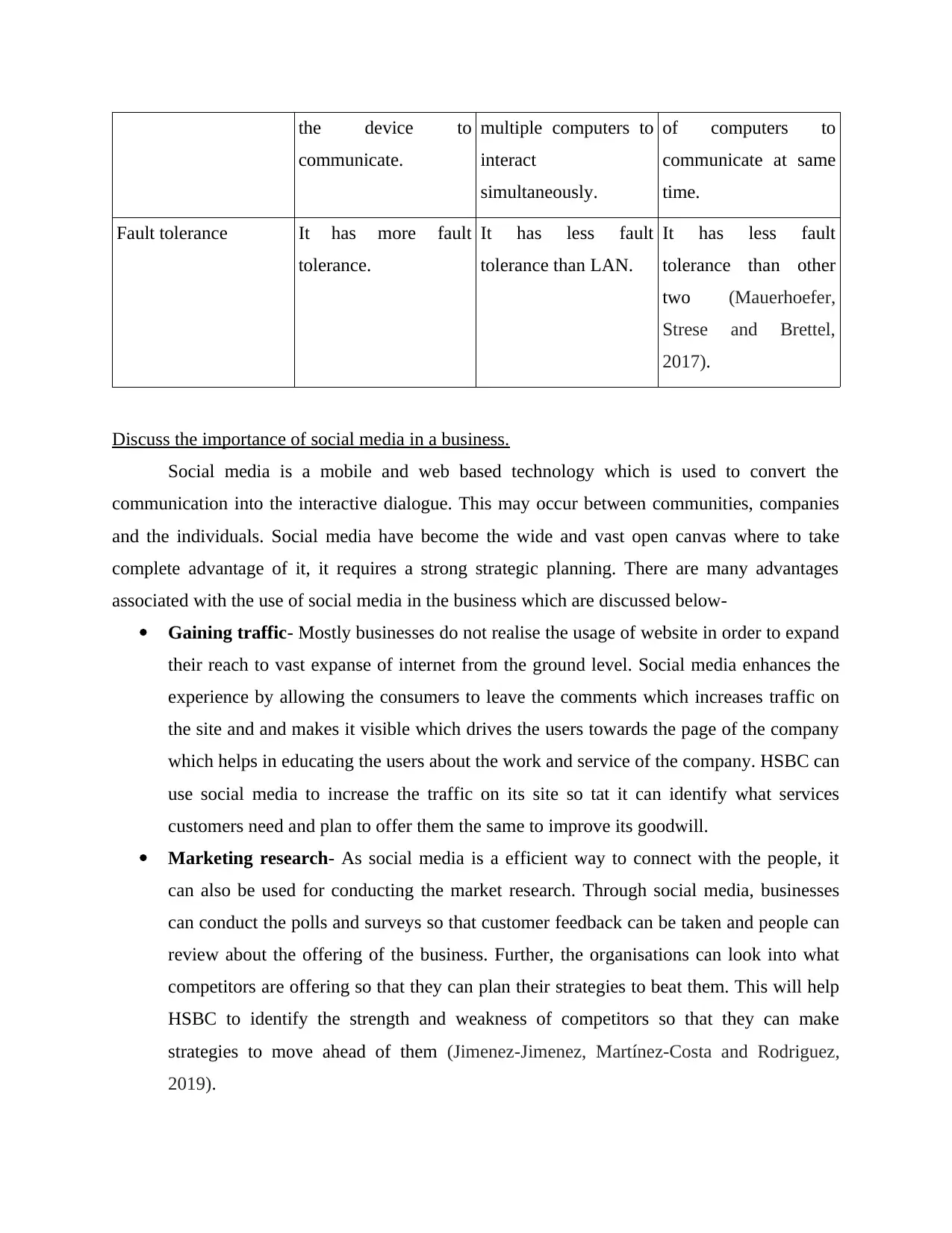
the device to
communicate.
multiple computers to
interact
simultaneously.
of computers to
communicate at same
time.
Fault tolerance It has more fault
tolerance.
It has less fault
tolerance than LAN.
It has less fault
tolerance than other
two (Mauerhoefer,
Strese and Brettel,
2017).
Discuss the importance of social media in a business.
Social media is a mobile and web based technology which is used to convert the
communication into the interactive dialogue. This may occur between communities, companies
and the individuals. Social media have become the wide and vast open canvas where to take
complete advantage of it, it requires a strong strategic planning. There are many advantages
associated with the use of social media in the business which are discussed below-
Gaining traffic- Mostly businesses do not realise the usage of website in order to expand
their reach to vast expanse of internet from the ground level. Social media enhances the
experience by allowing the consumers to leave the comments which increases traffic on
the site and and makes it visible which drives the users towards the page of the company
which helps in educating the users about the work and service of the company. HSBC can
use social media to increase the traffic on its site so tat it can identify what services
customers need and plan to offer them the same to improve its goodwill.
Marketing research- As social media is a efficient way to connect with the people, it
can also be used for conducting the market research. Through social media, businesses
can conduct the polls and surveys so that customer feedback can be taken and people can
review about the offering of the business. Further, the organisations can look into what
competitors are offering so that they can plan their strategies to beat them. This will help
HSBC to identify the strength and weakness of competitors so that they can make
strategies to move ahead of them (Jimenez-Jimenez, Martínez-Costa and Rodriguez,
2019).
communicate.
multiple computers to
interact
simultaneously.
of computers to
communicate at same
time.
Fault tolerance It has more fault
tolerance.
It has less fault
tolerance than LAN.
It has less fault
tolerance than other
two (Mauerhoefer,
Strese and Brettel,
2017).
Discuss the importance of social media in a business.
Social media is a mobile and web based technology which is used to convert the
communication into the interactive dialogue. This may occur between communities, companies
and the individuals. Social media have become the wide and vast open canvas where to take
complete advantage of it, it requires a strong strategic planning. There are many advantages
associated with the use of social media in the business which are discussed below-
Gaining traffic- Mostly businesses do not realise the usage of website in order to expand
their reach to vast expanse of internet from the ground level. Social media enhances the
experience by allowing the consumers to leave the comments which increases traffic on
the site and and makes it visible which drives the users towards the page of the company
which helps in educating the users about the work and service of the company. HSBC can
use social media to increase the traffic on its site so tat it can identify what services
customers need and plan to offer them the same to improve its goodwill.
Marketing research- As social media is a efficient way to connect with the people, it
can also be used for conducting the market research. Through social media, businesses
can conduct the polls and surveys so that customer feedback can be taken and people can
review about the offering of the business. Further, the organisations can look into what
competitors are offering so that they can plan their strategies to beat them. This will help
HSBC to identify the strength and weakness of competitors so that they can make
strategies to move ahead of them (Jimenez-Jimenez, Martínez-Costa and Rodriguez,
2019).
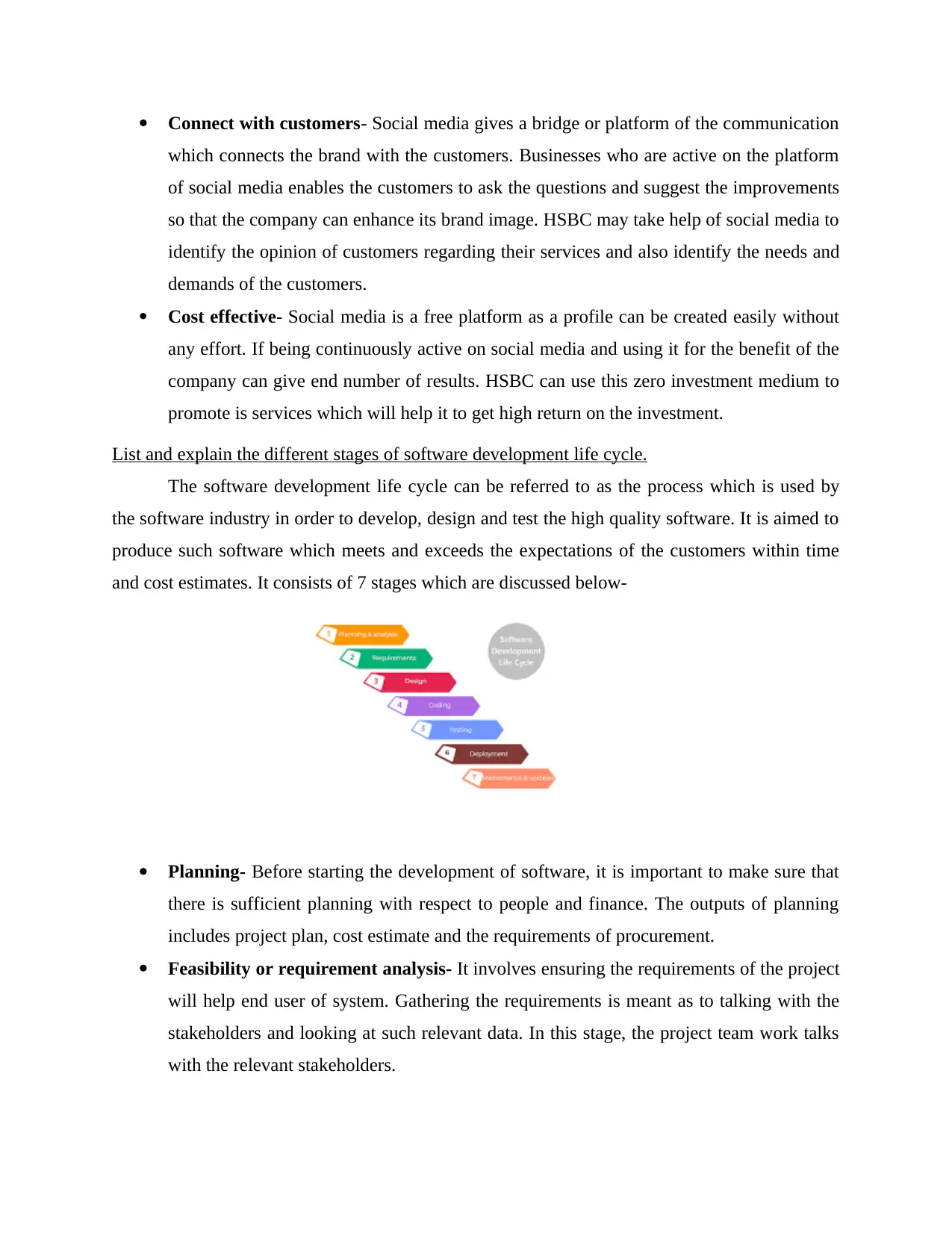
Connect with customers- Social media gives a bridge or platform of the communication
which connects the brand with the customers. Businesses who are active on the platform
of social media enables the customers to ask the questions and suggest the improvements
so that the company can enhance its brand image. HSBC may take help of social media to
identify the opinion of customers regarding their services and also identify the needs and
demands of the customers.
Cost effective- Social media is a free platform as a profile can be created easily without
any effort. If being continuously active on social media and using it for the benefit of the
company can give end number of results. HSBC can use this zero investment medium to
promote is services which will help it to get high return on the investment.
List and explain the different stages of software development life cycle.
The software development life cycle can be referred to as the process which is used by
the software industry in order to develop, design and test the high quality software. It is aimed to
produce such software which meets and exceeds the expectations of the customers within time
and cost estimates. It consists of 7 stages which are discussed below-
Planning- Before starting the development of software, it is important to make sure that
there is sufficient planning with respect to people and finance. The outputs of planning
includes project plan, cost estimate and the requirements of procurement.
Feasibility or requirement analysis- It involves ensuring the requirements of the project
will help end user of system. Gathering the requirements is meant as to talking with the
stakeholders and looking at such relevant data. In this stage, the project team work talks
with the relevant stakeholders.
which connects the brand with the customers. Businesses who are active on the platform
of social media enables the customers to ask the questions and suggest the improvements
so that the company can enhance its brand image. HSBC may take help of social media to
identify the opinion of customers regarding their services and also identify the needs and
demands of the customers.
Cost effective- Social media is a free platform as a profile can be created easily without
any effort. If being continuously active on social media and using it for the benefit of the
company can give end number of results. HSBC can use this zero investment medium to
promote is services which will help it to get high return on the investment.
List and explain the different stages of software development life cycle.
The software development life cycle can be referred to as the process which is used by
the software industry in order to develop, design and test the high quality software. It is aimed to
produce such software which meets and exceeds the expectations of the customers within time
and cost estimates. It consists of 7 stages which are discussed below-
Planning- Before starting the development of software, it is important to make sure that
there is sufficient planning with respect to people and finance. The outputs of planning
includes project plan, cost estimate and the requirements of procurement.
Feasibility or requirement analysis- It involves ensuring the requirements of the project
will help end user of system. Gathering the requirements is meant as to talking with the
stakeholders and looking at such relevant data. In this stage, the project team work talks
with the relevant stakeholders.
⊘ This is a preview!⊘
Do you want full access?
Subscribe today to unlock all pages.

Trusted by 1+ million students worldwide
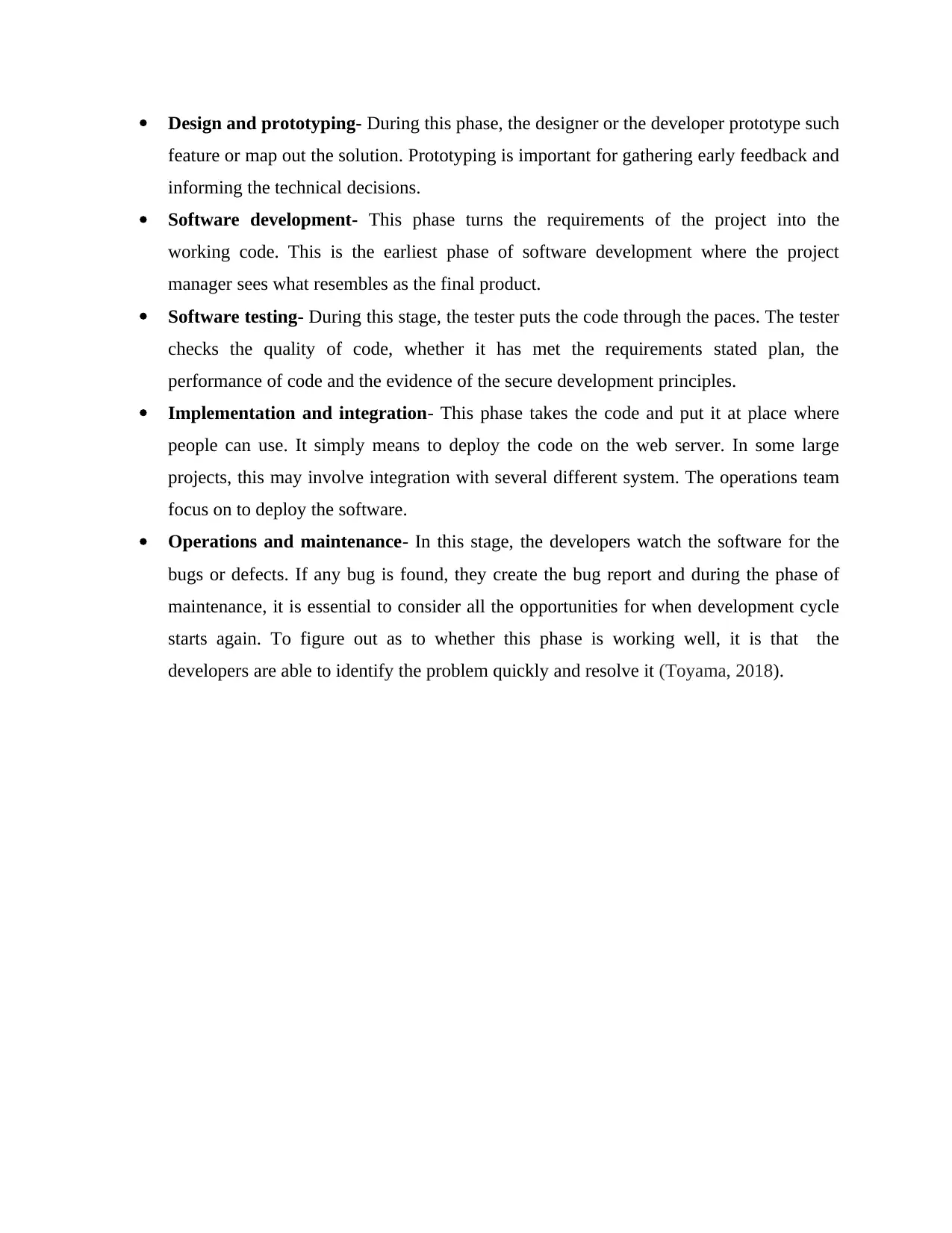
Design and prototyping- During this phase, the designer or the developer prototype such
feature or map out the solution. Prototyping is important for gathering early feedback and
informing the technical decisions.
Software development- This phase turns the requirements of the project into the
working code. This is the earliest phase of software development where the project
manager sees what resembles as the final product.
Software testing- During this stage, the tester puts the code through the paces. The tester
checks the quality of code, whether it has met the requirements stated plan, the
performance of code and the evidence of the secure development principles.
Implementation and integration- This phase takes the code and put it at place where
people can use. It simply means to deploy the code on the web server. In some large
projects, this may involve integration with several different system. The operations team
focus on to deploy the software.
Operations and maintenance- In this stage, the developers watch the software for the
bugs or defects. If any bug is found, they create the bug report and during the phase of
maintenance, it is essential to consider all the opportunities for when development cycle
starts again. To figure out as to whether this phase is working well, it is that the
developers are able to identify the problem quickly and resolve it (Toyama, 2018).
feature or map out the solution. Prototyping is important for gathering early feedback and
informing the technical decisions.
Software development- This phase turns the requirements of the project into the
working code. This is the earliest phase of software development where the project
manager sees what resembles as the final product.
Software testing- During this stage, the tester puts the code through the paces. The tester
checks the quality of code, whether it has met the requirements stated plan, the
performance of code and the evidence of the secure development principles.
Implementation and integration- This phase takes the code and put it at place where
people can use. It simply means to deploy the code on the web server. In some large
projects, this may involve integration with several different system. The operations team
focus on to deploy the software.
Operations and maintenance- In this stage, the developers watch the software for the
bugs or defects. If any bug is found, they create the bug report and during the phase of
maintenance, it is essential to consider all the opportunities for when development cycle
starts again. To figure out as to whether this phase is working well, it is that the
developers are able to identify the problem quickly and resolve it (Toyama, 2018).
Paraphrase This Document
Need a fresh take? Get an instant paraphrase of this document with our AI Paraphraser
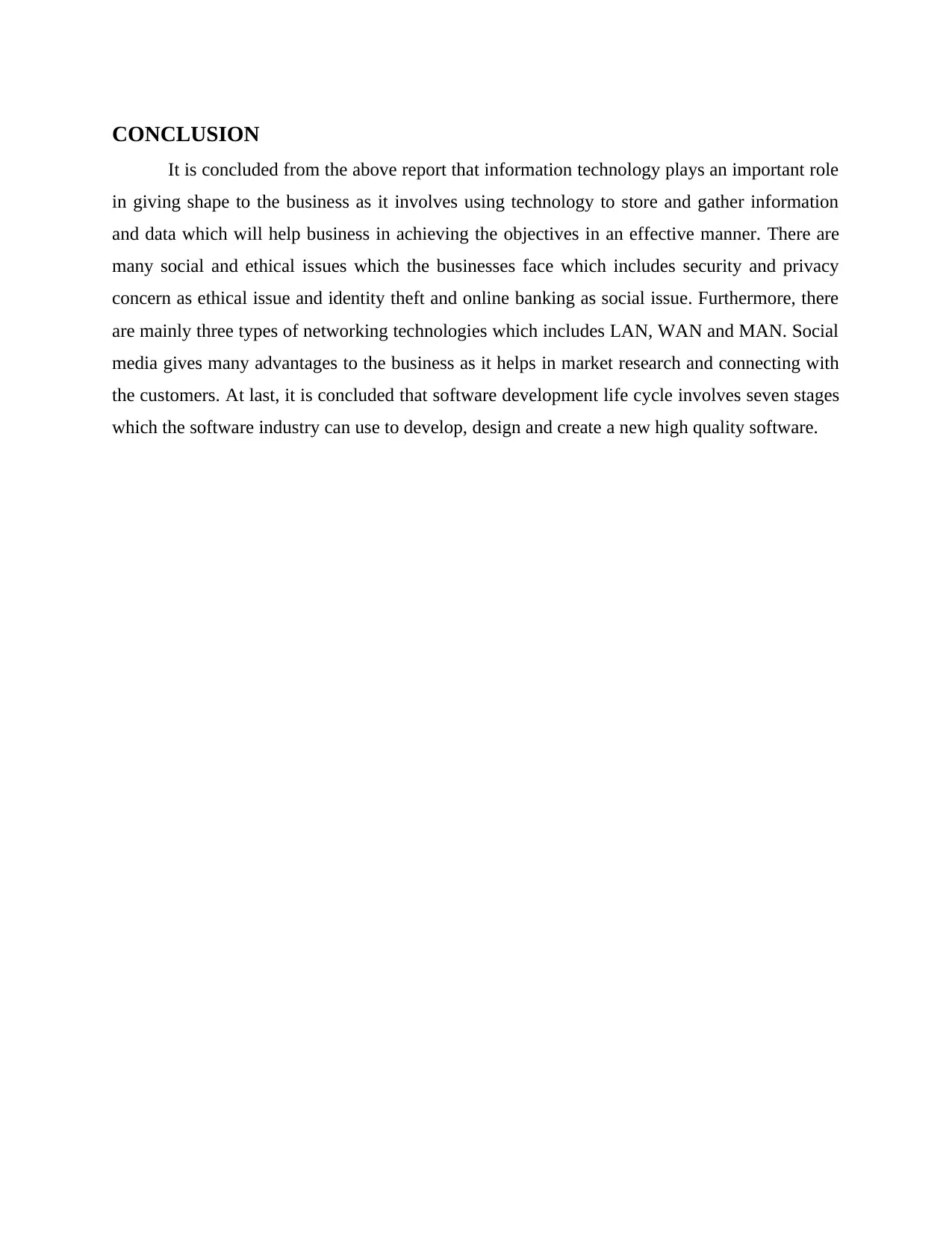
CONCLUSION
It is concluded from the above report that information technology plays an important role
in giving shape to the business as it involves using technology to store and gather information
and data which will help business in achieving the objectives in an effective manner. There are
many social and ethical issues which the businesses face which includes security and privacy
concern as ethical issue and identity theft and online banking as social issue. Furthermore, there
are mainly three types of networking technologies which includes LAN, WAN and MAN. Social
media gives many advantages to the business as it helps in market research and connecting with
the customers. At last, it is concluded that software development life cycle involves seven stages
which the software industry can use to develop, design and create a new high quality software.
It is concluded from the above report that information technology plays an important role
in giving shape to the business as it involves using technology to store and gather information
and data which will help business in achieving the objectives in an effective manner. There are
many social and ethical issues which the businesses face which includes security and privacy
concern as ethical issue and identity theft and online banking as social issue. Furthermore, there
are mainly three types of networking technologies which includes LAN, WAN and MAN. Social
media gives many advantages to the business as it helps in market research and connecting with
the customers. At last, it is concluded that software development life cycle involves seven stages
which the software industry can use to develop, design and create a new high quality software.
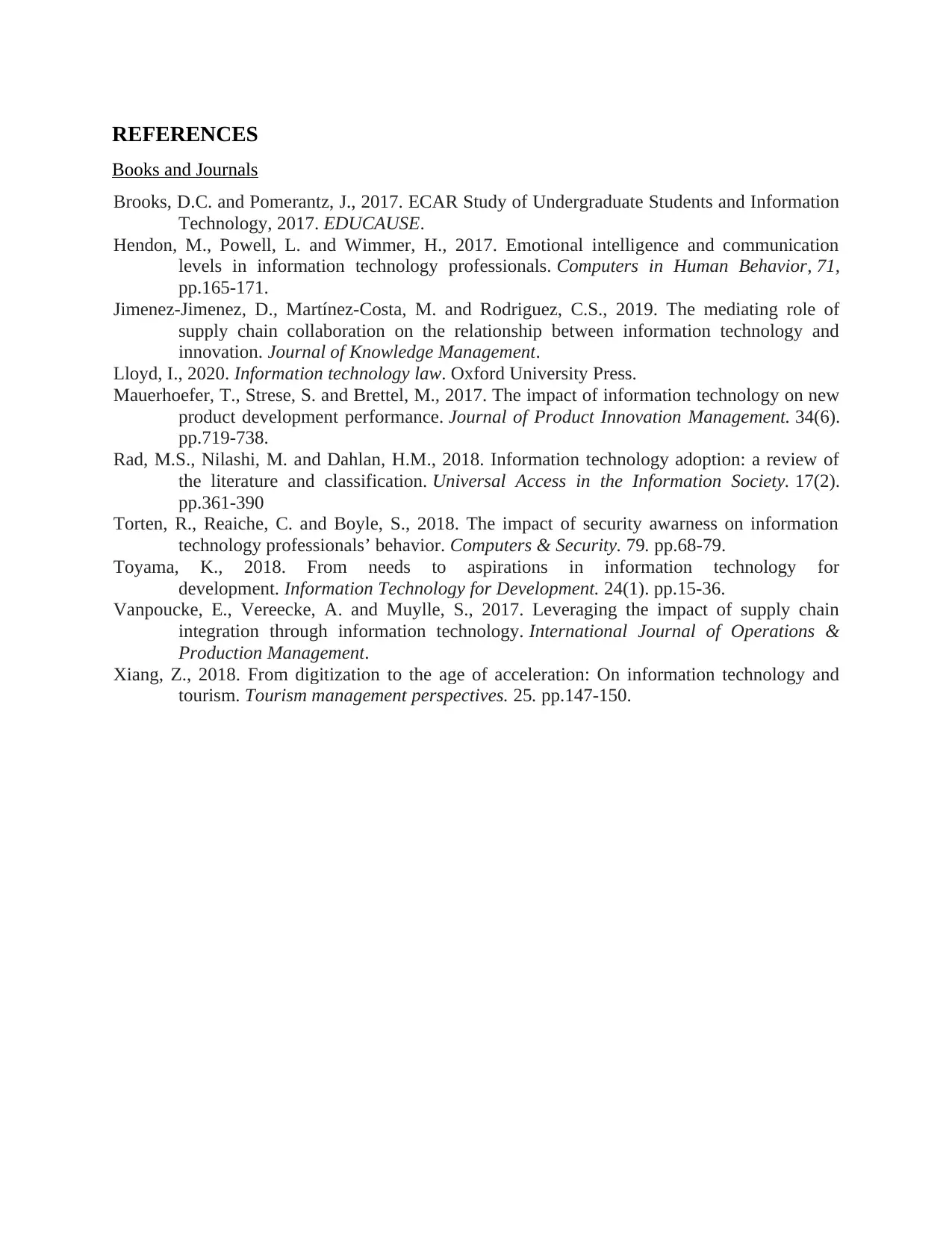
REFERENCES
Books and Journals
Brooks, D.C. and Pomerantz, J., 2017. ECAR Study of Undergraduate Students and Information
Technology, 2017. EDUCAUSE.
Hendon, M., Powell, L. and Wimmer, H., 2017. Emotional intelligence and communication
levels in information technology professionals. Computers in Human Behavior, 71,
pp.165-171.
Jimenez-Jimenez, D., Martínez-Costa, M. and Rodriguez, C.S., 2019. The mediating role of
supply chain collaboration on the relationship between information technology and
innovation. Journal of Knowledge Management.
Lloyd, I., 2020. Information technology law. Oxford University Press.
Mauerhoefer, T., Strese, S. and Brettel, M., 2017. The impact of information technology on new
product development performance. Journal of Product Innovation Management. 34(6).
pp.719-738.
Rad, M.S., Nilashi, M. and Dahlan, H.M., 2018. Information technology adoption: a review of
the literature and classification. Universal Access in the Information Society. 17(2).
pp.361-390
Torten, R., Reaiche, C. and Boyle, S., 2018. The impact of security awarness on information
technology professionals’ behavior. Computers & Security. 79. pp.68-79.
Toyama, K., 2018. From needs to aspirations in information technology for
development. Information Technology for Development. 24(1). pp.15-36.
Vanpoucke, E., Vereecke, A. and Muylle, S., 2017. Leveraging the impact of supply chain
integration through information technology. International Journal of Operations &
Production Management.
Xiang, Z., 2018. From digitization to the age of acceleration: On information technology and
tourism. Tourism management perspectives. 25. pp.147-150.
Books and Journals
Brooks, D.C. and Pomerantz, J., 2017. ECAR Study of Undergraduate Students and Information
Technology, 2017. EDUCAUSE.
Hendon, M., Powell, L. and Wimmer, H., 2017. Emotional intelligence and communication
levels in information technology professionals. Computers in Human Behavior, 71,
pp.165-171.
Jimenez-Jimenez, D., Martínez-Costa, M. and Rodriguez, C.S., 2019. The mediating role of
supply chain collaboration on the relationship between information technology and
innovation. Journal of Knowledge Management.
Lloyd, I., 2020. Information technology law. Oxford University Press.
Mauerhoefer, T., Strese, S. and Brettel, M., 2017. The impact of information technology on new
product development performance. Journal of Product Innovation Management. 34(6).
pp.719-738.
Rad, M.S., Nilashi, M. and Dahlan, H.M., 2018. Information technology adoption: a review of
the literature and classification. Universal Access in the Information Society. 17(2).
pp.361-390
Torten, R., Reaiche, C. and Boyle, S., 2018. The impact of security awarness on information
technology professionals’ behavior. Computers & Security. 79. pp.68-79.
Toyama, K., 2018. From needs to aspirations in information technology for
development. Information Technology for Development. 24(1). pp.15-36.
Vanpoucke, E., Vereecke, A. and Muylle, S., 2017. Leveraging the impact of supply chain
integration through information technology. International Journal of Operations &
Production Management.
Xiang, Z., 2018. From digitization to the age of acceleration: On information technology and
tourism. Tourism management perspectives. 25. pp.147-150.
⊘ This is a preview!⊘
Do you want full access?
Subscribe today to unlock all pages.

Trusted by 1+ million students worldwide
1 out of 12
Related Documents
Your All-in-One AI-Powered Toolkit for Academic Success.
+13062052269
info@desklib.com
Available 24*7 on WhatsApp / Email
![[object Object]](/_next/static/media/star-bottom.7253800d.svg)
Unlock your academic potential
Copyright © 2020–2025 A2Z Services. All Rights Reserved. Developed and managed by ZUCOL.




